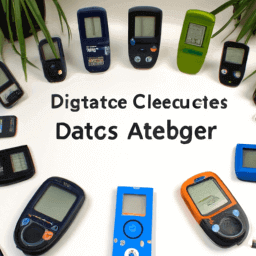What are the different types of glucometer?
There are several types of glucometers available in the market. The most common type is the traditional blood glucose meter that requires a finger prick to draw blood for testing. Another type is the continuous glucose monitoring system (CGM) that uses a sensor inserted under the skin to measure glucose levels continuously. Some glucometers also come with additional features such as Bluetooth connectivity, data storage, and insulin dose recommendation. There are also non-invasive glucometers that use infrared light to measure glucose levels without the need for a finger prick. Lastly, there are smartphone-connected glucometers that allow users to track their glucose levels through an app.
Types of Glucometer
Glucometer, also known as a blood glucose meter, is a medical device used to measure the glucose level in the blood. It is a vital tool for people with diabetes to monitor their blood sugar levels regularly. There are different types of glucometers available in the market, each with its unique features and benefits. In this article, we will discuss the different types of glucometers.
1. Self-Monitoring Blood Glucose (SMBG) Meter
SMBG meters are the most commonly used type of glucometer. They are portable and easy to use, making them ideal for people with diabetes who need to monitor their blood sugar levels frequently. SMBG meters use a small drop of blood, usually from the fingertip, to measure the glucose level in the blood. The user inserts a test strip into the meter, pricks their finger with a lancet to obtain a drop of blood, and then applies the blood to the test strip. The meter then displays the glucose level in mg/dL or mmol/L.
2. Continuous Glucose Monitoring (CGM) System
A CGM system is a more advanced type of glucometer that continuously monitors the glucose level in the blood. It consists of a small sensor that is inserted under the skin to measure the glucose level in the interstitial fluid (fluid between cells). The sensor is connected to a transmitter that sends the glucose readings to a receiver or smartphone app. CGM systems provide real-time glucose readings and can alert the user if their glucose level is too high or too low. They are particularly useful for people with diabetes who experience frequent hypoglycemia (low blood sugar) or hyperglycemia (high blood sugar).
3. Flash Glucose Monitoring (FGM) System
FGM systems are similar to CGM systems, but instead of providing continuous glucose readings, they provide glucose readings on demand. The user wears a small sensor on their skin, which measures the glucose level in the interstitial fluid. To obtain a glucose reading, the user scans the sensor with a reader or smartphone app. FGM systems are less invasive than CGM systems and do not require calibration with a fingerstick blood glucose test.
4. Non-Invasive Glucose Monitoring (NIGM) System
NIGM systems are still in the development stage, but they have the potential to revolutionize glucose monitoring for people with diabetes. NIGM systems use non-invasive techniques, such as infrared spectroscopy or optical coherence tomography, to measure the glucose level in the blood without the need for a blood sample. However, NIGM systems are not yet widely available, and their accuracy and reliability are still being tested.
Comparison Table
| Type of Glucometer | Method of Glucose Measurement | Frequency of Glucose Readings | Accuracy | Cost |
|---|---|---|---|---|
| Self-Monitoring Blood Glucose (SMBG) Meter | Blood sample from fingertip | Multiple times per day | High | Low |
| Continuous Glucose Monitoring (CGM) System | Interstitial fluid via sensor under the skin | Continuous | High | High |
| Flash Glucose Monitoring (FGM) System | Interstitial fluid via sensor on the skin | On demand | High | High |
| Non-Invasive Glucose Monitoring (NIGM) System | Infrared spectroscopy or optical coherence tomography | Not yet available | Unknown | Unknown |
| By www.zelect.in | ||||
Conclusion
Choosing the right type of glucometer depends on the individual's needs and preferences. SMBG meters are the most commonly used type of glucometer and are suitable for most people with diabetes. CGM and FGM systems are more advanced and provide real-time glucose readings, making them particularly useful for people with diabetes who experience frequent hypoglycemia or hyperglycemia. NIGM systems have the potential to revolutionize glucose monitoring, but they are not yet widely available. Consult with a healthcare professional to determine which type of glucometer is best for you.
Sharing is caring!
Facebook Twitter Email
Recommended articles for Glucometer
Glucometer types and buying guide
-
Is there a glucose meter without strips?
-
What are the different types of glucometer?
-
How much difference between glucometer and lab test?
-
What is normal sugar level in glucometer
-
Glucometer buying guide. how to choose best glucometer?
-
Which glucometer is best and give accurate result


